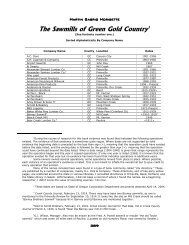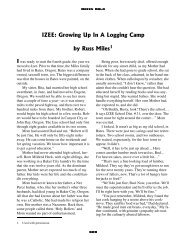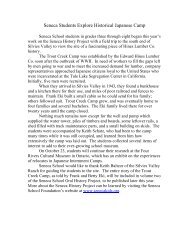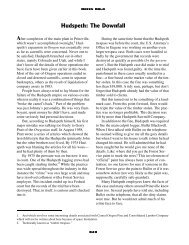09-WB Marshall.pdf - The Seneca School Foundation
09-WB Marshall.pdf - The Seneca School Foundation
09-WB Marshall.pdf - The Seneca School Foundation
Create successful ePaper yourself
Turn your PDF publications into a flip-book with our unique Google optimized e-Paper software.
Yet no other information—save some genealogical<br />
information ferreted by the ever-digging Don<br />
Houk who has found a lot about this industrious<br />
man—sees to exist. William McMeeken (sometimes<br />
spelled McMeekin and once even Mac-<br />
Meeken) remains a mystery. Here is what little<br />
I’ve been able to learn. 3<br />
William McMeekin's father and grandfather<br />
were both named William. <strong>The</strong> eldest William,<br />
born in 1804, married Nancy Jane Hale on May<br />
23, 1865—obviously not his first marriage. William<br />
the first's son, William II, born 1825, married<br />
Nancy Jane Baker on June 17, 1866, adding more<br />
confusion to the family tree.<br />
At the time of the 1900 census Willie was living<br />
next door to Sam Compton in the McKay precinct.<br />
By 1910, Willie now age 65, was living in<br />
the Joseph Smith household in the Willow Creek<br />
precinct. Willie's wife, Mary, had died in 19<strong>09</strong><br />
and left her entire estate to Al Cubitt who must<br />
have been a family friend. By the 1910 census,<br />
both Cubitt and McMeekin were living with<br />
Joseph Smith in the Willow Creek district.<br />
Mary's motives in leaving her estate to Al<br />
may have been this: William, at age 64, wouldn't<br />
be around much longer and probably needed care.<br />
That care may have been provided by Mr. Cubitt.<br />
<strong>The</strong> newspaper article continues:<br />
<strong>The</strong> first planing mill in Prineville was<br />
build in 1875 by John Hamilton on the corner<br />
which the Prineville creamery now<br />
occupies [southeast corner, North Beaver<br />
& West 4th streets]. Here was made the finishing<br />
lumber for the first courthouse and,<br />
the first schoolhouse as well as many other<br />
buildings. Hamilton sold this planing mill<br />
to Maling who later sold it to me. I<br />
took in John B. Shipp 4 as a partner<br />
and later sold my interest to<br />
him and started another. This second<br />
mill burned in 1878 and that<br />
closed my ventures in wood working<br />
shops. I had always worked in<br />
metal before coming here.<br />
<strong>The</strong> narrator of this story, now<br />
assumed to be Gardiner Perry, lived an<br />
interesting life and since these details are<br />
not preserved elsewhere and because the<br />
narrator was, although he didn't make<br />
such a claim, working in the timber<br />
industry they will be set forth here without<br />
further interruption.<br />
During the next few years I<br />
worked for others and for the<br />
county and built all the bridges<br />
put up in Crook county which<br />
included what is now Crook, Des-<br />
3. All of this is compliments of Don Houk and his extensive research into incomplete and inaccurate records. Don’s persistence<br />
paid off and I can now write what follows about Wm. McMeekin.<br />
4. This seems to suggest that the person telling the story is Gardiner Perry. Shipp & Perry were partners in business<br />
together as early as 1900. Known as Shipp & Perry, they were known to operate a saw mill and planing mill and were “manufacturers<br />
of lumber and shingles.” Additional information about the Shipp & Perry business will be provided elsewhere in<br />
this book.







